The Family as Basic Social Unit: Living Out Catholic Social Teaching. By Kevin Schemenauer. Reviewed by Rev. Ryan Connors. (skip to review)
A Guide to John Henry Newman: His Life and Thought. Ed. by Juan R. Velez. Reviewed by Rev. Martin X. Moleski, SJ. (skip to review)
George Cardinal Pell: Pax Invictis. By Tess Livingstone. Reviewed by Rev. Andrew Walsh. (skip to review)
The Center Is Jesus Christ Himself: Essays on Revelation, Salvation & Evangelization in Honor of Robert Imbelli. Ed. by Andrew Meszaros. Reviewed by Dillon Vita. (skip to review)
Commentary on the Holy Rule of St. Benedict. By Alfredo Ildefonso Schuster. Reviewed by K.E. Colombini. (skip to review)
The Family as Basic Social Unit – Kevin Schemenauer
Schemenauer, Kevin. The Family as Basic Social Unit: Living Out Catholic Social Teaching. Washington, DC: The Catholic University of America Press, 2024. 277 + xvi pages.
Reviewed by Rev. Ryan Connors.
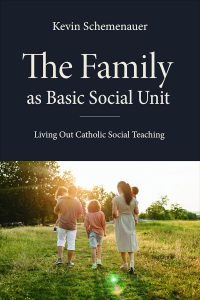 In the 2009 encyclical Caritas in Veritate, Pope Benedict XVI called for a deeper integration between those who advance the Church’s social teaching on matters of economics and those who advocate for the dignity of human life. Put simply, pro-life supporters and social justice advocates should come together and see their work as a coherent whole. Living fully the Church’s social teaching — and understanding it properly — presents no easy task. Too many persons confuse the Church’s teaching for partisan politics or a middle way between socialism and libertarianism. For his part, Kevin Schemenauer offers crucial wisdom in his The Family as Basic Social Unit: Living Out Catholic Social Teaching.
In the 2009 encyclical Caritas in Veritate, Pope Benedict XVI called for a deeper integration between those who advance the Church’s social teaching on matters of economics and those who advocate for the dignity of human life. Put simply, pro-life supporters and social justice advocates should come together and see their work as a coherent whole. Living fully the Church’s social teaching — and understanding it properly — presents no easy task. Too many persons confuse the Church’s teaching for partisan politics or a middle way between socialism and libertarianism. For his part, Kevin Schemenauer offers crucial wisdom in his The Family as Basic Social Unit: Living Out Catholic Social Teaching.
Professor Schemenauer expounds on two fundamental convictions: the family is internally social and socially interdependent. Understanding correctly these two assertions will prove necessary to appreciate the fullness of the Church’s social wisdom.
The book unfolds in seven chapters. In the first chapter, Schemenauer highlights the family’s essential social role. Laying stress on this point will have consequences in many areas, including on a mother’s role in the family and in the workforce. The author finds wanting the typical division between the private work of child-rearing and the public, social role women may place in the workplace. Instead, since the family is essentially social this division falls flat. Social contract theory, which stresses individual choice and children as commodity, cannot account for the family’s essentially social reality.
In Chapter Two, the author demonstrates how the principles of Catholic Social Thought apply to family life. One rarely reads about how subsidiarity would apply to child-raising, or about how the principle of solidarity might encourage remaining in contact with family in difficult circumstances. The author explains how two principles — the dignity of work and peace-making — apply to family life. These reflections include important considerations about how best to understand a living wage. All in all, he applies the principles of Catholic Social Thought to the dynamics of family life.
The third chapter describes how readers can apply the corporal and spiritual works of mercy to the good works of family life. Again, the author explores the inadequacy of the division between family as a private affair and public, ad extra activities as social. Instead, he shows how families can practice the works of mercy among themselves. The chapter also includes one of the best descriptions currently available of the history of Christian reflection on the works of mercy.
With the fourth chapter, the book moves to its second main portion on the social interdependence of families. Social interdependence opposes isolation. The author explains: “[f]amilies should not merely tolerate others who are perceived as a mere burden . . . [i]n hospitality families should welcome and invite others” (136). Recalling the teaching of Pope John Paul II’s Christifideles laici (1988), the author argues that families have a duty toward responsible participation in community life.
In addressing the challenge of consumerism (Chapter Five) and how to live simplicity (Chapter Six) the author describes convincingly the challenges families face today. Many persons assert that they wish to put family first in life. Too often, however, this aspiration is derailed when it is misunderstood as principally seeking financial security for one’s family instead of making efforts at character formation (178). These cultural challenges induce many people to seek “not the Kingdom of God but the ‘magical kingdom’ of Disney” (179).
Drawing on the work of Dietrich von Hildebrand and St. Francis de Sales, Schemenauer argues that a recovery of the neglected virtue of simplicity offers the antidote to the challenge of consumerism. He cautions against an overly dramatic withdrawal from society. His emphasis on the inherently social character of the family means that he emphasizes that families need the job opportunities, political order, and enriching web of relationships that social engagement makes possible. What is needed is an ethical framework to assist families to navigate these moral challenges. The author demonstrates that the cultivation of virtues — he highlights especially gratitude, prayer, and simplicity — will prove more useful than ready-made, casuist-like solutions to the manifold dilemmas which face modern families.
With Chapter Seven the author describes familial responsibilities toward the poor. He offers practical suggestions of how families can discern how best they can assist those around them, starting with those closest to them. Throughout the book, Schemenauer draws generously from the insights of diverse thinkers, like Lisa Sowle Cahill (Boston College) and John Grabowski (The Catholic University of America). He appears equally comfortable quoting from the teaching of Pope John Paul II’s Familiaris consortio (1981) or Pope Francis’s Amoris laetitia (2016). He captures the best of magisterial teaching, new and old, as well as from contemporary social commentators and theologians.
At all times the text manifests a balanced approach to a series of disputed cultural topics. The balanced and serene approach, however, should not be confused for a hesitancy to take a strong stand. Rather, the text offers a sober reflection that avoids polemics and exaggerated claims. Instead, the author writes from a place of confidence in the capacity of Catholic Social Teaching to address difficulties that arise in modern family life. The scope is considerable and the insights well worth the reader’s time. Theologians and other interested believers stand in the author’s debt for this significant achievement.
Rev. Ryan Connors is Rector of the Seminary of Our Lady of Providence (Rhode Island). He is the author of many publications including Rethinking Cooperation with Evil: A Virtue-Based Approach (Washington, DC: The Catholic University of America Press, 2023) and Moral Theology: An Introduction (Cape Girardeau, MO: ECT Press, 2025).
A Guide to John Henry Newman – ed. Juan R. Velez
Velez, Juan R., ed. A Guide to John Henry Newman: His Life and Thought. Washington, D.C.: The Catholic University of America Press, 2022. 553+xix pages.
Reviewed by Martin X. Moleski, SJ.
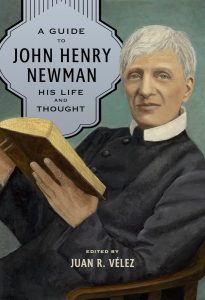 The twenty-seven essays in this book are “an academic work” written by people who love Newman for others who already know and love Newman (xv). The authors are “fully convinced of Newman’ s integrity, spiritual greatness, and orthodoxy” (xix) and intend to give “an overall picture [. . .] with scholarly rigor” (xvi). They presume that the reader will understand allusions to the great sorrows and profound joys in Newman’s life that influenced the development of his heart and mind. For those who have never taken an introductory course in Newman, this book will not be of much help; for me, it was informative and invigorating to see new treasures as well as old drawn out of the immense store of Newman’s writings.
The twenty-seven essays in this book are “an academic work” written by people who love Newman for others who already know and love Newman (xv). The authors are “fully convinced of Newman’ s integrity, spiritual greatness, and orthodoxy” (xix) and intend to give “an overall picture [. . .] with scholarly rigor” (xvi). They presume that the reader will understand allusions to the great sorrows and profound joys in Newman’s life that influenced the development of his heart and mind. For those who have never taken an introductory course in Newman, this book will not be of much help; for me, it was informative and invigorating to see new treasures as well as old drawn out of the immense store of Newman’s writings.
I took special delight in Newman’s contrast between the spirituality of the Oratory of St. Philip Neri and that of the Jesuits. He compared the “grave, unmoved bearing of a Jesuit” with “a Philippian, whose spirit is to conceal seriousness under great cheerfulness, simplicity, modesty, and humor [and] sits in an easy chair, in a lounging posture, one hand stretched on a table, with bright sparkling eyes and a merry countenance” (176–177). The great affection Newman found among a multitude of friends, which is detailed in three essays (56–104), suggests that this may well be something of a self-portrait. “His friendships constitute a sort of treatise comparable to any of this theological masterpieces” (93).
Newman’s devotion to the education of the laity undoubtedly set the stage for the deepened appreciation of their gifts in Vatican II. “I want a laity, not arrogant, not rash in speech, not disputatious, but men who know . . . their creed so well, that they can give an account of it, who know so much of history that they can defend it” (170). He praised the faithful who were “obstinate champions of the Catholic truth” after Nicea, while “the bishops were not” (463). At the same time, he was as mistrustful of self-taught theologians as he would be of “amateur doctors and still more lawyers” (473). “In all times the laity have been the measure of Catholic spirit; they saved the Irish Church three centuries ago, [but] they betrayed the Church in England” (481).
It is clear from the sins and crimes committed by priests in our day that ordination does not make men holy, but neither does the lack of orders make the unordained a source of preternatural innocence and wisdom. Both the ordained and unordained members of the Church today are deeply divided about what are and are not proper developments in the understanding of doctrine, regardless of their exposure to formal education. Newman is the great champion of the role of conscience in our lives. Benedict XVI said that his life and work “is one great commentary on the question of conscience” (337). Newman knew well that our conscience can go astray: “In this century,” he said, conscience “has been superseded by a counterfeit, which the eighteen centuries prior to it never heard of, and could not have mistaken for it, if they had. It is the right of self-will [. . .] an Englishman’s prerogative to be his own master in all things” (348). This is not a new phenomenon. Doubtless the man who seduced his father’s wife (1 Cor 5:1–5) would have claimed that his conscience was clear, and he might even have quoted Paul about how the death of Jesus sets us free from the dead hand of the law and the burden of good works.
My impression as I made my way through this collection was that Newman was a man of constant sorrow. He failed to win honors in his university exams (142), had a near death experience himself and lost his beloved sister, Mary, a year later (416). His conversion to Catholicism cost him friends and public acclaim. “Newman lost every contest of the direction of an institution in which he was engaged”: the Tractarian movement, the reform of the tutoring system at Oriel, the preservation of moral philosophy at Oxford, and the foundation of the Irish university (231). The judgment that he was guilty of defamation in the Achilli trial cost him an immense amount in legal fees and did an incalculable amount of damage to his reputation. He endured these trials by faith. In his own devotion to the saints, he saw that “their lingering imperfections surely make us love them more, without leading us to reverence them less” (170), and this is precisely what I felt in reading these meditations on Newman’s life and teaching. I admire him as an exemplar of his own maxim about how to persevere in the faith: “in our height of hope, ever to be sober, and in our depth of desolation, never to despair” (“The Second Spring,” 1852).
Rev. Martin X. Moleski, SJ, currently serves as an assistant to the editors of Biblica and Orientalia at the Pontifical Biblical Institute in Rome. Before this assignment, he taught Religious Studies and Catholic Theology for two years at LeMoyne College in Syracuse and for twenty-eight years at Canisius College in Buffalo.
George Cardinal Pell – Tess Livingstone
Livingstone, Tess. George Cardinal Pell: Pax Invictis. San Francisco, CA: Ignatius Press, 2024. 544 pages.
Reviewed by Fr. Andrew Walsh.
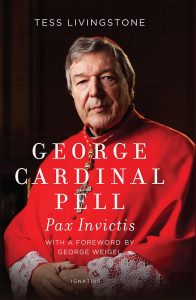 With her book George Cardinal Pell, Tess Livingstone has given us an important biography of her friend and a sort of vademecum for priests and Church leaders today. Building on her previous book, written in 2002, Livingstone brought the story of Cardinal Pell up to date and to its conclusion with his untimely death in 2023. Besides adding the title “Cardinal” to the book title, the author also changed the subtitle from “Defender of the Faith Down Under” to “Pax Invictis” — an inscription on a war memorial that Pell admired. “Peace to the Unconquered” is a fitting tribute to a man who fought and suffered for Jesus Christ and the Catholic Church which he loved so much.
With her book George Cardinal Pell, Tess Livingstone has given us an important biography of her friend and a sort of vademecum for priests and Church leaders today. Building on her previous book, written in 2002, Livingstone brought the story of Cardinal Pell up to date and to its conclusion with his untimely death in 2023. Besides adding the title “Cardinal” to the book title, the author also changed the subtitle from “Defender of the Faith Down Under” to “Pax Invictis” — an inscription on a war memorial that Pell admired. “Peace to the Unconquered” is a fitting tribute to a man who fought and suffered for Jesus Christ and the Catholic Church which he loved so much.
Following a foreword by a longtime friend of Pell, George Weigel, and a prologue by the author, the book recounts the funeral Mass for the Cardinal at Saint Mary’s Cathedral in Sydney and the memorial Mass two weeks earlier at Saint Peter’s Basilica in Rome. Two more chapters round out the first part of the biography covering the current state of the Catholic Church, including the financial corruption Cardinal Pell was tapped to fix and his pseudonymous memo about the Francis pontificate and what would be needed by the next pope. Just before he died Pell criticized the Synod on Synodality as a “toxic nightmare” and the Synod’s guiding document as “one of the most incoherent documents ever sent out from Rome.” Those who knew the Cardinal were not surprised since he is reported to have slammed his fist on the table during the 2014 Synod and shouted, “You must stop manipulating this Synod.” This final detail, sadly, didn’t make the book.
After four chapters, Livingstone takes the reader back to the beginning, when George Pell was born in Ballarat, Victoria, on Trinity Sunday, June 8, 1941. It becomes clear that the early life of Pell forged the character of a man who influenced the Church more than any other Australian. A close-knit, loving family provided support and business acumen. Australian football made Pell tough and his education gave him a love for learning. Seminary in Rome and doctoral studies in Oxford — Pell studied Church history — sharpened his penetrating intellect. Pastoral work in the countryside gave way to academics and administration as the bishop appointed him principal of Aquinas College. Ten years of hard work at the helm saved the small college, something Pell thought to be “one of the best things I have done.” Moving into seminary formation as the rector of his alma mater, Corpus Christi College, taught the seasoned priest about the importance of priestly formation and the difficulties of bringing change to that area.
In 1987, after almost 21 years as a priest, George Pell was consecrated an auxiliary bishop of Melbourne, where he served with Archbishop Frank Little. Though the relationship between the ordinary and his assistant was warm, they varied widely on their theological views and their approach to problems. In 1996 Pell was named by Pope John Paul II as the Archbishop of Melbourne, then as Archbishop of Sydney in 2001. World Youth Day came to Sydney in 2008 and the archbishop hosted half a million people from 200 countries and welcomed them down under for a hugely successful event. Pell served on many congregations and commissions at the Vatican over the years and was appointed by Pope Francis for a five-year term as the first prefect of the newly created Secretariat for the Economy in 2014.
As a bishop George Pell was know for his spirited defense of Church teachings in the face of opposition. Much later Pope Emeritus Benedict was to write Pell in prison and say, “You have helped the Catholic Church in Australia, with great success, to come out of a destructive liberalism, guiding her again to the wideness and beauty of the Catholic faith.” Indeed, Pell used every chance he had — whether preaching, presenting, or writing — to push back against the prevailing zeitgeist with the perennial philosophy and wisdom of the Church. This includes intra-church struggles he faced over doctrine and financial corruption.
Cardinal Pell and his contemporary bishops will all be remembered for their response to or negligence toward one of the greatest scandals in the history of the Catholic Church: the priestly abuse of children. Pell’s character made him an early responder to this tragic situation. Ultimately he would endure a sham trial and 404 days in prison as a consequence of the Church’s lost moral standing and the vindictive nature of a modern world that has abandoned faith.
Priests and Church leaders would do well to learn from and imitate the life of George Cardinal Pell. The battles he fought, the victories he won, and the suffering he endured face all those who seek to live as modern day disciples who are faithful to Jesus Christ and his Church.
Rev. Andrew Walsh is a parish priest in the Diocese of Wichita, Kansas.
The Center Is Jesus Christ Himself – ed. Andrew Meszaros
Meszaros, Andrew, ed. The Center Is Jesus Christ Himself: Essays on Revelation, Salvation & Evangelization in Honor of Robert Imbelli. Washington, D.C.: The Catholic University of America Press, 2021. 311 pages.
Reviewed by Dillon Vita.
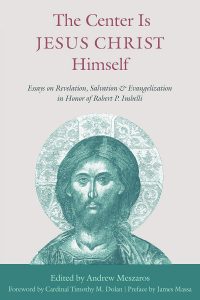 When one first opens The Center Is Jesus Christ Himself, one is struck by the impressive list of contributors, which includes Matthew Levering, Thomas Weinandy, and Thomas Guarino, among others. The articles collected in this festschrift are as interesting as they are impressive. They do not concentrate on a particular topic, but the editor, Andrew Meszaros, has organized them according to their topic (1: The Center of Revelation; 2: The Center of the Economy of Salvation; 3: The Center of the Christian Life; 4: The Center of Evangelization). Even if the articles do not coalesce upon a particular topic, they are written by truly eminent scholars at their best and any reader will emerge from this book having received a treasure trove of wisdom.
When one first opens The Center Is Jesus Christ Himself, one is struck by the impressive list of contributors, which includes Matthew Levering, Thomas Weinandy, and Thomas Guarino, among others. The articles collected in this festschrift are as interesting as they are impressive. They do not concentrate on a particular topic, but the editor, Andrew Meszaros, has organized them according to their topic (1: The Center of Revelation; 2: The Center of the Economy of Salvation; 3: The Center of the Christian Life; 4: The Center of Evangelization). Even if the articles do not coalesce upon a particular topic, they are written by truly eminent scholars at their best and any reader will emerge from this book having received a treasure trove of wisdom.
Fr. Robert Imbelli was an esteemed teacher who taught or worked alongside many of the contributors of this collection. According to Meszaros, the throughline of the collection is that they all “are ‘Christocentric’” (xvii), which is a well-chosen governing theme because it has governed so much of the honoree’s life. Fr. Imbelli is known most especially for his conviction that the Second Vatican Council’s particular genius was its call for the Church to return to its center and foundation, that is to say, to Christ. As is made plain in this book, Fr. Imbelli’s defense of Dominus Iesus, the Congregation of the Doctrine of the Faith’s Declaration on the Unicity and Salvific Universality of Jesus Christ and the Church from 2000, was motivated by this very same conviction. Allowing Christ to take His rightful place at the center of theology and of reality, frees us to behold the truth rather than constrain us from exercising our freedom for there is only freedom in the truth.
As fitting as it is to have the centrality of Christ be the organizing theme of a festschrift for a man who has given his life to the promotion of a Christocentric theology, it strikes me as odd that in a number of these articles in honor of Fr. Imbelli, his name does not appear. If one were to approach this festschrift with the hope that one might understand better the thought of Fr. Robert Imbelli, or at least his reception, one would be let down by this book. This is partly by design, as his impact was not so much in some new contribution to the field of theology but in his defense of Christ and his handing down of the teaching of the Church in the classroom. However, there are a few articles that do not even frame themselves in light of the occasion of this book. Many of the articles do add an introduction and conclusion orienting themselves to Fr. Imbelli’s work, thus not forcing the reader to undergo this labor himself, and some of the articles, such as Thomas Guarino’s splendid piece, are expositions of the thought of Fr. Imbelli.
This is a mild complaint of a book that is so full of wisdom and insight, but it would have contributed to the greater cohesion of the book if each article made explicit the reason for its inclusion in a festschrift to Fr. Robert Imbelli. If one were seeking a theologically erudite and Christocentric book to read by the fire, this book would be a suitable choice.
Dillon Vita is a seminarian for the Diocese of Rockville Centre at Saint Joseph’s Seminary and College (Dunwoodie), New York.
Commentary on the Holy Rule of Saint Benedict – Alfredo Ildefonso Schuster
Schuster, Alfredo Ildefonso. Commentary on the Holy Rule of Saint Benedict. Brooklyn, NY: Angelico Press, 2023 (1945). 318 pages.
Reviewed by K.E. Colombini.
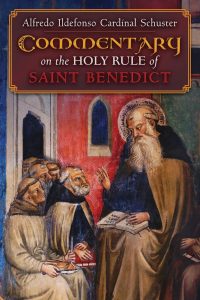 We’re coming up to the sesquimillenial of the Rule of St. Benedict, and Catholics and other Christians can’t stop talking about it. St. Benedict’s way of life, originally written in 530, has spawned a cottage industry of writers seeking to apply it to modern life.
We’re coming up to the sesquimillenial of the Rule of St. Benedict, and Catholics and other Christians can’t stop talking about it. St. Benedict’s way of life, originally written in 530, has spawned a cottage industry of writers seeking to apply it to modern life.
One Benedictine monk, Fr. J. Augustine Wetta of St. Louis Abbey, has written Humility Rules: Saint Benedict’s Twelve-Step Guide to Genuine Self-Esteem (Ignatius Press, 2018), noting that the rule “offers the antidote to the epidemic of stress and depression overwhelming modern young adults.” Another popular writer, Benedictine Sr. Joan Chittister, sees in the rule “A spirituality for the 21st Century,” as she subtitles a recent book (Crossroad, 2010). An Italian book on Amazon applies the rule to family life, and a 2005 Purdue University Press book connects the Holy Rule to . . . business success.
Perhaps more importantly, in 2017, Rod Dreher’s bestseller The Benedict Option called for resistance to the modern world through the creation of enduring intentional Christian communities based on some of the great saint’s principles, such as hospitality, stability, and prayer. Dreher based his book on a quote from the philosopher Alasdair MacIntyre, from his 1981 work After Virtue, where he concluded: “What matters at this stage is the construction of local forms of community within which civility and the intellectual and moral life can be sustained through the new dark ages which are already upon us. . . . We are waiting not for a Godot but for another — doubtless very different — St. Benedict.”
As anyone who has read Lord of the Flies can tell you, communities need rules. And the fact that St. Benedict’s rules have endured for so long speaks to the depth of their wisdom. Monastics and others read portions the rule and reflect on it daily, and it clearly has a place in the hearts of much of the laity. This new book, a 2023 reprint of a 1945 volume from Blessed Alfredo Ildefonso Schuster, dives deep into its riches. Bl. Schuster lived from 1880–1954. Although a Benedictine monk, he served as Cardinal Archbishop of Milan from 1929 until his death. He was beatified by Pope John Paul II in 1996.
Benedict’s Rule is remarkable for the brevity with which it covers a wide range of topics necessary not just for a monastery but, truly, any community, and that is part of its appeal. This Commentary offers a worthy explanation of the various chapters over the course of Church history, replete with reflections from Church fathers and doctors.
At the end of his Commentary, Schuster notes his homesickness for the cloister and reflects on the need for his order to stay strong and rebuild after the devastation wrought by the World War on important abbeys like Montecassino.
To judge by our meager human standards, we see a happy future traced before the family of St. Benedict, when the period of rebuilding follows after the universal cataclysm of the war. It is in our abbeys — and the people know it — that there has always been kept burning the twofold lamp of liturgical piety and knowledge of God. Our age seems especially oriented toward these two currents of Christian life. It is to be hoped that, disillusioned by everything that has, for so many years, fed human pride, flattering it that it could do without God, if not actually rebel against Him, the postwar generation will return, as in the Middle Ages, to seek God in the Dominici schola servitii.
The postwar years indeed saw a rise in monastic vocations; just witness the explosive growth seen with the debut, only a few years later, of Thomas Merton’s The Seven Story Mountain. Now, the Benedictine Order is seeing growth in places like Norcia and Clear Creek, by embracing what Schuster discusses here — liturgical piety and knowledge of God. They will likewise be a boon to the Church at large, and we can only pray for their success and support them with our treasure and talent. This book provides a suitable deeper commentary on the rule of life that has fed the Church and created so many saints for a millennium and a half.
K.E. Colombini writes from St. Louis. In addition to HPR, his work has been seen in First Things, Crisis Magazine, Front Porch Republic, National Catholic Register and elsewhere.

Recent Comments